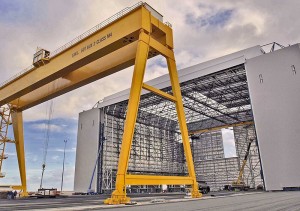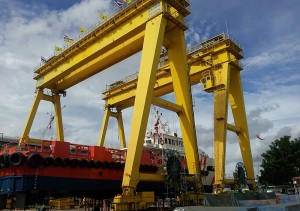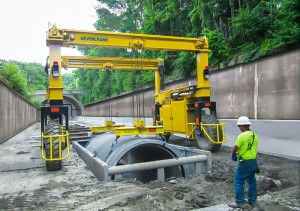
Heavy Duty Rail Mounted Gantry Crane for Sale
Product Details and Features
Rail-mounted gantry cranes (RMGs) are specialized cranes used in container terminals and intermodal yards to handle and stack shipping containers. They are designed to operate on rails and provide efficient container handling capabilities. Here are some key features of rail-mounted gantry cranes:
Rail-Mounted Design: RMGs are mounted on railway tracks or gantry rails, allowing them to travel along a fixed path in the terminal or yard. The rail-mounted design provides stability and precise movement for container handling operations.
Span and Lifting Capacity: RMGs typically have a large span to cover multiple container rows and can handle a wide range of container sizes. They are available in various lifting capacities, ranging from tens to hundreds of tons, depending on the specific requirements of the terminal.
Stacking Height: RMGs are capable of stacking containers vertically to maximize the use of available space in the terminal. They can lift containers to significant heights, usually up to five to six containers high, depending on the crane’s configuration and lifting capacity.
Trolley and Spreader: RMGs are equipped with a trolley system that runs along the main beam of the crane. The trolley carries a spreader, which is used to lift and lower containers. The spreader can be adjusted to fit different container sizes and types.
Application
Container Terminals: RMGs are widely used in container terminals for handling and stacking shipping containers. They play a crucial role in loading and unloading containers from ships, as well as transferring containers between different areas of the terminal, such as storage yards, truck loading areas, and rail sidings.
Intermodal Yards: RMGs are employed in intermodal yards where containers are transferred between different modes of transportation, such as ships, trucks, and trains. They enable efficient and organized container handling, ensuring smooth transfers and optimizing the flow of cargo.
Rail Freight Terminals: Rail-mounted gantry cranes are used in rail freight terminals to handle containers and other heavy loads for train loading and unloading operations. They facilitate the efficient transfer of cargo between trains and trucks or storage areas.
Industrial Facilities: RMGs find applications in various industrial facilities where heavy loads need to be moved and stacked. They are used in manufacturing plants, warehouses, and distribution centers for handling materials, components, and finished products.
Port Expansion and Upgrades: When expanding or upgrading existing ports, rail-mounted gantry cranes are often installed to increase container handling capacity and improve operational efficiency. They enable efficient use of available space and enhance the overall productivity of the port.







Product Process
Design and Engineering: The process begins with the design and engineering phase, where the specific requirements of the rail-mounted gantry crane are determined. This includes factors such as lifting capacity, span, stacking height, automation features, and safety considerations. Engineers use computer-aided design (CAD) software to develop detailed 3D models of the crane, including the main structure, trolley system, spreader, electrical systems, and control mechanisms.
Material Preparation and Fabrication: Once the design is finalized, the manufacturing process starts with the preparation of materials. High-quality steel sections and plates are procured according to the specifications. The steel materials are then cut, shaped, and fabricated into various components, such as beams, columns, legs, and bracings, using processes like cutting, welding, and machining. The fabrication is done in accordance with industry standards and quality control measures.
Assembly: In the assembly stage, the fabricated components are brought together to form the main structure of the rail-mounted gantry crane. This includes the main beam, legs, and supporting structures. The trolley system, which includes the hoisting machinery, trolley frame, and spreader, is assembled and integrated with the main structure. Electrical systems, such as power supply cables, control panels, motors, sensors, and safety devices, are installed and connected to ensure proper functioning and control of the crane.














